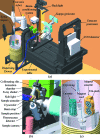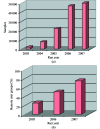New paradigm for macromolecular crystallography experiments at SSRL: automated crystal screening and remote data collection
- PMID: 19018097
- PMCID: PMC2631117
- DOI: 10.1107/S0907444908030564
New paradigm for macromolecular crystallography experiments at SSRL: automated crystal screening and remote data collection
Abstract
Complete automation of the macromolecular crystallography experiment has been achieved at SSRL through the combination of robust mechanized experimental hardware and a flexible control system with an intuitive user interface. These highly reliable systems have enabled crystallography experiments to be carried out from the researchers' home institutions and other remote locations while retaining complete control over even the most challenging systems. A breakthrough component of the system, the Stanford Auto-Mounter (SAM), has enabled the efficient mounting of cryocooled samples without human intervention. Taking advantage of this automation, researchers have successfully screened more than 200 000 samples to select the crystals with the best diffraction quality for data collection as well as to determine optimal crystallization and cryocooling conditions. These systems, which have been deployed on all SSRL macromolecular crystallography beamlines and several beamlines worldwide, are used by more than 80 research groups in remote locations, establishing a new paradigm for macromolecular crystallography experimentation.
Figures







Similar articles
-
The Stanford Automated Mounter: Enabling High-Throughput Protein Crystal Screening at SSRL.JALA Charlottesv Va. 2008 Dec 1;13(6):335-343. doi: 10.1016/j.jala.2008.08.008. JALA Charlottesv Va. 2008. PMID: 19956359 Free PMC article.
-
Remote access to crystallography beamlines at SSRL: novel tools for training, education and collaboration.J Appl Crystallogr. 2010 Oct 1;43(Pt 5):1261-1270. doi: 10.1107/S0021889810024696. Epub 2010 Aug 3. J Appl Crystallogr. 2010. PMID: 22184477 Free PMC article.
-
The Stanford Automated Mounter: pushing the limits of sample exchange at the SSRL macromolecular crystallography beamlines.J Appl Crystallogr. 2016 Feb 24;49(Pt 2):622-626. doi: 10.1107/S1600576716000649. eCollection 2016 Apr 1. J Appl Crystallogr. 2016. PMID: 27047309 Free PMC article.
-
Small but mighty: the power of microcrystals in structural biology.IUCrJ. 2025 May 1;12(Pt 3):262-279. doi: 10.1107/S2052252525001484. IUCrJ. 2025. PMID: 40080159 Free PMC article. Review.
-
[Protein micro-crystallography with a new micro-beam beamline].Yakugaku Zasshi. 2010 May;130(5):641-8. doi: 10.1248/yakushi.130.641. Yakugaku Zasshi. 2010. PMID: 20460858 Review. Japanese.
Cited by
-
X-ray crystal structure of the cytochrome P450 2B4 active site mutant F297A in complex with clopidogrel: insights into compensatory rearrangements of the binding pocket.Arch Biochem Biophys. 2013 Feb 15;530(2):64-72. doi: 10.1016/j.abb.2012.12.016. Epub 2013 Jan 4. Arch Biochem Biophys. 2013. PMID: 23296089 Free PMC article.
-
Structural analysis of a class III preQ1 riboswitch reveals an aptamer distant from a ribosome-binding site regulated by fast dynamics.Proc Natl Acad Sci U S A. 2015 Jul 7;112(27):E3485-94. doi: 10.1073/pnas.1503955112. Epub 2015 Jun 23. Proc Natl Acad Sci U S A. 2015. PMID: 26106162 Free PMC article.
-
Fully automatic characterization and data collection from crystals of biological macromolecules.Acta Crystallogr D Biol Crystallogr. 2015 Aug;71(Pt 8):1757-67. doi: 10.1107/S1399004715011918. Epub 2015 Jul 31. Acta Crystallogr D Biol Crystallogr. 2015. PMID: 26249356 Free PMC article.
-
Autoindexing with outlier rejection and identification of superimposed lattices.J Appl Crystallogr. 2010 Jun 1;43(Pt 3):611-616. doi: 10.1107/S0021889810010782. Epub 2010 Apr 30. J Appl Crystallogr. 2010. PMID: 20502598 Free PMC article.
-
JBluIce-EPICS control system for macromolecular crystallography.Acta Crystallogr D Biol Crystallogr. 2011 Mar;67(Pt 3):176-88. doi: 10.1107/S0907444910053916. Epub 2011 Feb 15. Acta Crystallogr D Biol Crystallogr. 2011. PMID: 21358048 Free PMC article.
References
Publication types
MeSH terms
Substances
Grants and funding
LinkOut - more resources
Full Text Sources
Other Literature Sources

